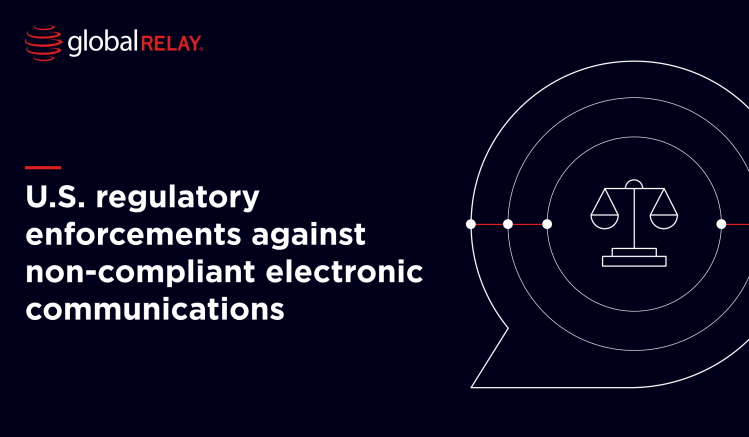Much like the feeling you get when first playing a board game with an abundance of instructions and strategies, navigating financial compliance can get complicated. Organizations must follow a sizeable number of regulatory guidelines to make sure they’re compliant, and from what we’ve seen with recent rule proposals, that list will very likely grow.
It has become commonplace for organizations to hear that they need to stay on top of compliance, keep employees in line, and invest in solutions that will store all data and enable effective communication monitoring.
While these points are valid, it’s tricky deciding where to start. Of course, any company would want to be in the clear if subject to regulatory scrutiny, but with so much information to communicate, data to capture, activities to monitor, and solutions to choose from, what comes first?
Compliance is not always simple, but using this checklist as a reference can be a great baseline. Much to the industry’s disappointment, there’s no magic solution to completely eliminate illicit activity or misbehavior, yet as illustrated in enforcement actions over the past few years, regulators acknowledge and respect proactivity. A big part of proactivity is staying on top of policies and procedures.
Policy management lays the groundwork for smooth operations, ensuring that all facets of your financial organization are in harmony and that staff members understand the expected course of action when it comes to appropriate behavior for communications and application use.
To get a head start on your policy, or revitalize existing policies, consider the points in the checklist below:
- Don’t just educate – demonstrate
A list of instructions on the company website can only be so effective. Of course, having clear policies in an easily accessible location is essential, but what really drives the point home is using examples to help form a complete and practical picture.
In the same way that people understand a new term or idea through analogies, it can help staff understand policies when compliance teams demonstrate examples of what’s appropriate, what’s not, what could be considered suspicious, and what could come across the wrong way.
In training sessions, explain where employees can find company policies around compliance. Send updates and schedule meetings to cover new additions or revisions to current policies. Make sure that employees know who they can reach out to if questions arise, and ensure compliance teams and leaders are available for assistance.
When educating employees on policies, it’s sometimes necessary to have delicate conversations about personal behavior and device use. Often, when employees use their own devices to communicate about business with a client or coworker, the line between personal and professional becomes muddled. Remind staff that conversations on work channels are no longer private – therefore, it is crucial to use discretion.
Firms must help staff understand that they aren’t looking to pry into private conversations but are instead watching for specific issues that would infringe upon regulations. Stress the bottom line, which is that businesses aim to provide employees with a safe parameter and environment to operate in.
- Noncompliance comes in all forms – monitor them all
Non-financial misconduct can have unfavorable effects on business in the same way as a financial crime, such as money laundering, does. Negative impacts of misconduct can compromise productivity, tarnish a firm’s reputation, and shatter client trust.
Any form of harassment or bullying is harmful on many levels and needs to be stopped immediately. Yet, as found in a Vault report, 31% of U.K. workers and 37% of U.S. workers don’t have faith that their organization would act against reported misconduct, which is surprisingly backed by 33% of U.K. and 30% of U.S. HR and compliance teams.
Consequently, communication and transparency go both ways – while it is critical for employees to listen to compliance teams and executive messages advising on appropriate behavior, it is equally as important for executives to act when employees raise concerns.
Misconduct sets off a domino effect on operations. Vault also found that when experiencing misconduct, 66% of employees reported a negative impact on productivity, and 45% even ended up leaving their roles.
It is not enough to catch these actions after the damage has already been done – they should be identified and handled before they can develop. In these situations, surveillance tools are invaluable, as they can flag content for review through the use of AI models and lexicons.
On the other hand, compliance breaches may not always be malicious, such as in the case of off-channel communications. If an employee responds to a client’s message on a platform that their organization doesn’t capture, for example, it is not always ill-intentioned but still a violation. Yet, these infractions comprise a sizable portion of noncompliance fines charged by regulators. Regardless of intentions, all noncompliance boils down to the same result – trouble.
For this reason, training and transparency works together with communications monitoring to help avoid misbehavior and keep firms on the right path.
- Compliance goes hand in hand with culture
Culture dictates tone, which influences an organization’s effectiveness overall. The spotlight on culture has become increasingly intense, and it is clear that regulators want to see a change that boosts market soundness and marks a shift in top-level transparency and honesty, especially considering that recent enforcement actions are oftentimes a result of misconduct from executives and managers.
Where executives and managers lead, employees will follow. It’s easy to say that compliance is a top priority, but as we know, actions speak louder than words. Beyond educating employees on a positive business ethos, it helps to incentivize productivity through goal setting. Where there is a vigorous and supportive culture, there is a stronger desire to do well.
Simply distributing your company’s codes of conduct in an email or posting them on the company page (likely never to be read) won’t do the trick. Leaders must show employees how to act with integrity and be analytical through their own actions. In addition, firms must emphasize that executives are not scrutinized any less when it comes to noncompliance – there are consequences regardless of your position, compliance officers included.
- Organize and identify teams and users
First and foremost, identify the compliance teams who manage and oversee your policies. A trusted group that can monitor business activity and counsel new and existing employees will frame the backbone of compliance. Compliance teams should also be well-informed on all regulatory rules and know what to look for when examining communications.
All teams within an organization will need access to a range of channels for a range of reasons. The marketing department may need to use social media platforms for business engagement, while the sales and client success departments may need to communicate with clients on specific messaging platforms. Compliance teams should tailor policies and procedures for each group so that there are customized directions detailing how to use the platform they operate.
It is also beneficial to sort through and document these teams and the platforms they utilize to build a comprehensive list of users. Doing so also clarifies the specific platforms that each department need access to so that compliance and security teams can restrict access to only those members, reducing the ability for risk. A breakdown of each team’s access doesn’t just help executives and compliance teams understand the structure of platform use, but can also help rapidly pinpoint issues in case something goes wrong.
- Employ tools to help support compliance
Instead of waiting for regulators to make a move, take charge. Establish practices at your organization to monitor for noncompliance or suspicious behavior, and squash suspect situations before they develop into something major. Surveillance tools are instrumental in allowing compliance teams to monitor communications by analyzing context and content to scope out possible violations.
A frequent noncompliance challenge firms face is deleted messages. If you do not have a foolproof tool that captures and stores information immediately, and on all channels, you are opening up the door to noncompliance. Once a message is gone, it is not coming back.
This is especially true given the adoption of modern communication channels, which are progressively multi-dimensional and offer a range of features that have compliance teams’ heads spinning. It is vital that every detail is captured, including features like emojis and gifs.
It all starts with strong policies, which are supported by positive examples and thorough education. It ends with a foolproof archive that safeguards records. Think of your communications data like a king piece in chess – once it is lost, it is game over.
Checkmate on compliance
Now is the time to strategize and discover the most effective ways that your firm can mitigate risks. Keep one step ahead and plan for any possibility so that if you ever fall into the match of compliance with regulators, you can be certain that you’ve fortified your organization against all potential avenues of insecurity.




